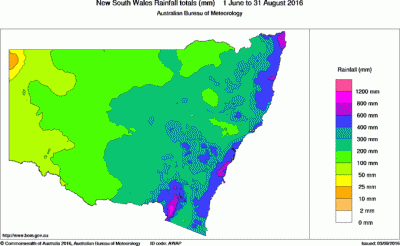THE big wet that has been drenching NSW in recent weeks is set to continue throughout September to November after the State saw the wettest August in 13 years.
Areas of the Northern Tablelands, North Coast and the Hunter Valley received more than 100–200 millimetres during August, whilst areas of the Central West, Central and Southern Tablelands, Riverina, far south and North West received between 50–100 mm.
NSW Department of Primary Industries (DPI) seasonal conditions coordinator, Ian McGowen, said during August most of the State received above average rainfall.
“77 per cent of NSW received wetter than normal conditions,” Mr McGowen said.
Relative to historical records August pasture growth was well above average across most of northern, north eastern, western and central NSW and near average across the remainder of the state. Pasture growth was restricted in some areas of the tablelands, far south east and far west, with some areas in central and southern NSW experiencing waterlogging.
“The early sown winter crops continue to show the best potential, with yields in better drained areas or on lighter soils likely to be average to above average,” Mr McGowen said.
Crop losses
“In some areas of the Central West and Riverina crop losses from 10-30 per cent of sown area to complete crop failure have occurred. Pulse crops have been worst affected.
“The wet conditions have greatly increased crop disease problems such as yellow leaf spot and stripe rust in wheat and net blotch and bacterial stripe in barley.
“Pulse crop diseases such as Ascochyta blight and Botrytis grey mould in chickpeas are also significant threats to production.”
During September wetter than normal conditions are likely across the southern areas of the central west, the western areas of the Riverina, areas of the far south and the southern half of the far west.
DPI Water, manager surface water, Brian Graham, said rain bands continued to track regularly across NSW producing strong runoff, storage improvements and increased water allocations.
“High priority entitlements across the State’s regulated river valleys have received full or near full allocations, and allocations to general security licences are improving from a generally low start to the year,” Mr Graham said.
The NSW Seasonal Conditions monthly report is available on the DPI website: www.dpi.nsw.gov.au




HAVE YOUR SAY